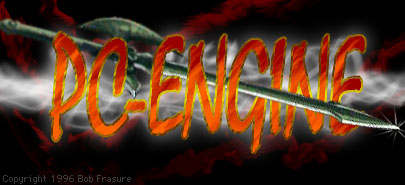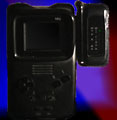

section
You have reached the


NEC of Japan did a great thing in 1987. They came out with a revolutionary system that has lasted longer than any other. The PC-Engine, as they called it, came to the world with force, and shook Nintendo's throne in Japan. Long hours and hard work went into the making of every piece of this machine, which, in the end, made the first affordable 16-bit system.
During its life span, NEC designed many other versions of the PC-Engine for different purposes. Some of these systems were for export to America (Like the TG-16 andDuo), others were designed for portability, but when it all came down to it, they were all designed for entertainment.
The first in the family is the PC-Engine. It was very small (about the size of a standard portable cd player). The power behind it was an 8-bit custom built processor that was surprisingly quick! Jam packed in the machine was a video card capable of displaying 512 colors simultanously. Since the PC-Engine was extrememly space efficient, a separate box had to be hooked up (known as the Turbo/Duo Tap in America) to get multiple players. Later a CD add on was created that totally humiliated everything that stood in the way of the PC-Engine.
The PC-Engine was white.
Now, thanks to the pictures Robert Soloway donated, everyone can now
see what the original PC-Engine and CD looks like!
A couple years down the road, 3 new PC-Engines were released.
The first of the new comers was known as the Core Grafx. The Core Grafx had a sleek new design to it, and a lower price tag. Unlike the PC-Engine, the Core Grafx was gray with blue lettering, and it included a dark controller as well with 3 turbo positions.Introduction retail price converted to American dollars (at the time) was about $175.
The second in the series was a system known as the PC-Engine Shuttle. Designed to look like a a futuristic shuttle, it had the qualities of a totally new game system design in Japan. On the back was a standard 48-pin socket for add-ons like memory but not a CD-Rom drive. The controller was a one-of-a-kind design, and probably wasn't easy to replace.
The last of the new introduction line in 1990 was the one-of-a-kind Super Grafx.
The Super Grafx was designed for larger sprites, impressive graphics, and speed. Visit the dedicated Super Grafx page for more info!
|
This is the Super Grafx |
 |

Down the road...
The spectacular PC-Engine GT was released. This mini wonder was a little larger than the Gameboy but was much better. The Turbo Express also was by far a more powerfull machine than the Lynx and the Game Gear. While it ran on pure battery power, the amount this system could do amazed everyone. The screen was made from active matrix LCD which (unlike all of the other systems) promoted no blurring. A TV attachment was also made for it.
Hot off the heels of the PC-Engine GT came more PC-Engines. The PC-Engine Duo came off of the line and amazed unsuspected people. The Duo was a combination of the PC-Engine and the recently released Super CD-ROM which was a combination of a double speed CD-Rom drive 2 megabits of memory (256k) and newer and faster methods of handling code. The Duo was a little larger than the PC-Engine because it was designed with the American market in mind.The extra room helped the system comply to America's FCC standards for minimizing the conflicts of many different machines with TV and radio signals.
NEC also tried to release the Duo as a portable machine. To do this, they released it with a matching active matrix small high quality monitor that sold for around $500 at the time, and a battery pack which clipped onto the back of the Duo that would last about 4 hours per charge. The monitor had been sold before, but it had been roughly $600, and it had not made very many sales. Also released at the same time was the PC Engine LCD TV (LT).
This device was a standard PC-Engine core unit with a built in controller and a monitor.It also included a TV attacment and a had a battery pack available. It plugged directly into PC-Engine units for use with a CD-Rom. The monitor used on this unit was the same active matrix LCD display used on the portable monitor that was placed next to the PC-Engine Duo.This system was quite expensive and was released for a short market test period before being yanked (correct me if I'm wrong!)
The Core Grafx II was released later, but it was virtually identical to the original Core Grafx besides the fact that it was a tan-gray color with orange lettering. Costs were cut, and changes were made. An entirely new design was applied.Later came other PC-Engine Duos.
The next Duo was known as the Duo-R. This Duo was designed to cut costs and un-necessary parts from the old Duo. Missing was the headphone jack. Also, since the black plastic was expensive to produce and mold, white plastic was used instead. The price of this unit was about $200- that is $100 less than the original Duo. The next Duo to be released (at least in the rumor mills) was the Duo-Rx which is the Duo R with a 6-button controller included for SFII and fighting game fans.
click this:
to go on to the PC-Engine Games Section
Take me back to the Un-Official Turbo Pages!
Note: The info and pictures provided here are not posted for the taking, but rather for the viewing. I have spent weeks hunting down info, and I do not want it abused.The original pictures (before editing) came from: Electronic Gaming Monthly, Gamepro, and TurboPlay. Without these magazines, this project would have been much harder! Also thanks to Robert Soloway for his generous 'original pc-engine w/ CD' pictures!